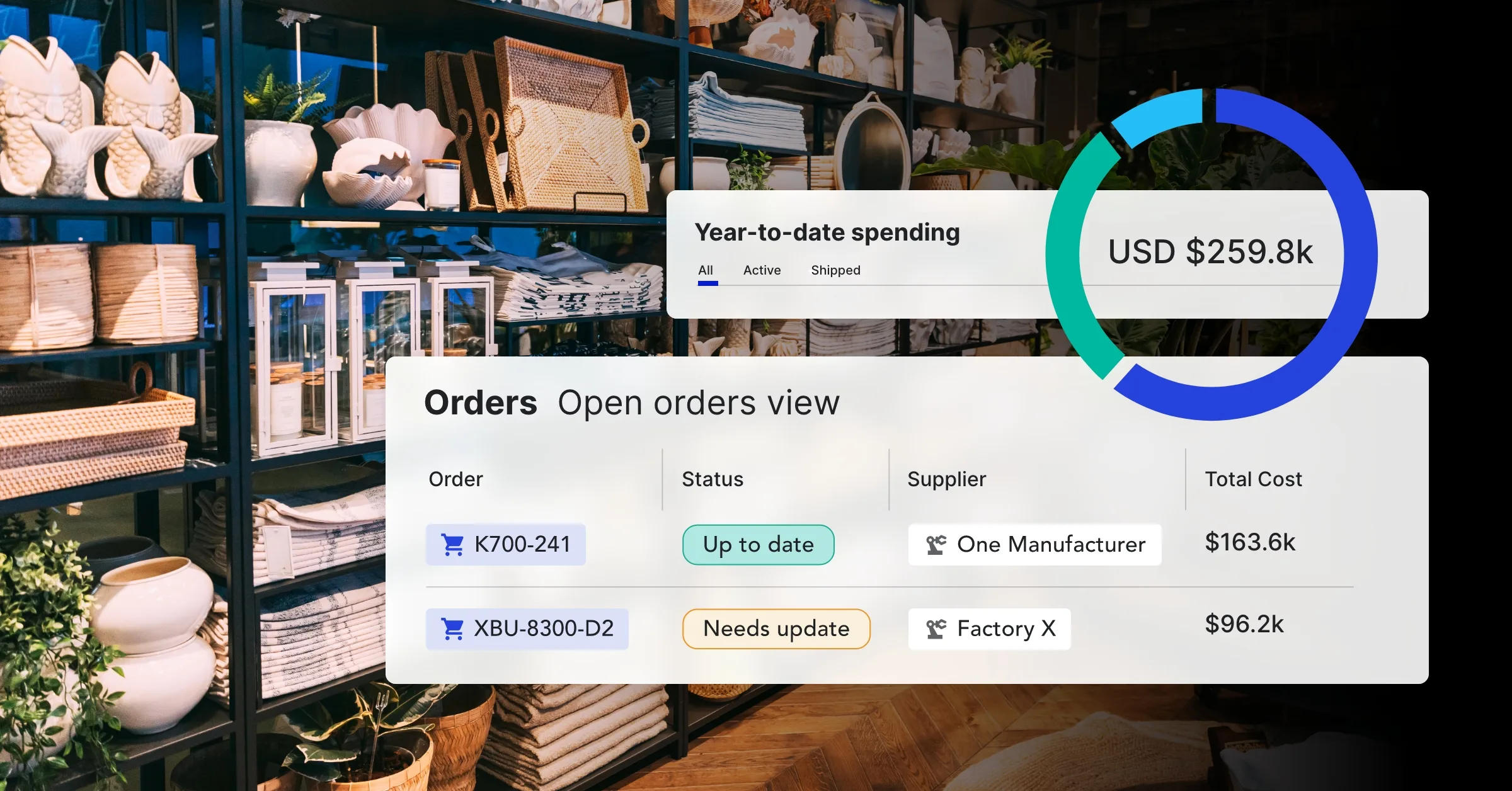Mastering purchase order management is crucial to maintaining an efficient supply chain.
But the more complex the supply chain, the more challenging it can be to manage purchase orders—especially for home goods and furniture brands selling across multiple channels and managing multiple suppliers in different parts of the world.
Despite these challenges, the global furniture market is still projected to be worth $650.7 billion by 2027, and the furniture E-commerce market in the United States alone is forecast to continuously increase by 29.1 billion U.S. dollars (41%) between 2024 and 2029.
Steady growth means that home goods and furniture brands need to manage purchase orders efficiently and effectively to keep up with demand.
So, how can home goods and furniture brands optimize their purchase order management processes to increase productivity and profitability and keep up with steady demand?
We’ll dive into that. But first, let’s clarify what a purchase order is and some of the most common purchase order management challenges home goods and furniture brands face.
What is a Purchase Order?
A purchase order (PO) is a formal document issued by a buyer to a seller outlining the purchase transaction details. It specifies the products or services to be acquired, quantities, agreed-upon prices, delivery dates, payment terms, and other relevant information.
What is Purchase Order Management?
Purchase order management is the internal procurement process adopted by home goods and furniture brands to ensure each purchase is necessary, justified, and cost-optimized.
Top purchase order management challenges for home goods and furniture brands
Home goods and furniture brands face many of the same challenges as other consumer brands—from managing inventory and keeping items in stock to keeping transportation costs low.
Other top challenges include:
- Supplier collaboration and communications: Negotiating pricing, maintaining quality standards, and ensuring on-time deliveries are all important aspects of day-to-day communications with suppliers. However, a lack of connection, clarity, and context on purchase orders can cause misalignment, which can lead to bottlenecks that waste time and create delays.
- Purchase Order Accuracy: Mistakes in purchase orders, such as incorrect quantities, items, or pricing, can ultimately result in delays and inventory discrepancies.
- Seasonality and Trends: Home goods and furniture sales are often influenced by seasonal trends and changes in consumer preferences. For example, consumers likely won’t purchase patio furniture in the middle of December. Predicting and adapting to these fluctuations in demand can be challenging and cause shortages or even inventory glut.
- SKU Proliferation: Home goods and furniture brands often offer a wide range of products with varying styles, colors, or finishes, resulting in many stock-keeping units (SKUs) that can be challenging to manage across disconnected systems.
- Compliance and Regulations: Home goods and furniture brands must comply with various regulations and industry standards regarding product safety, labeling, and environmental sustainability. Ensuring compliance with these requirements across the supply chain adds more complexity to the purchase order management processes.
The good news is that with the right supply chain tools and technology, you can address some of these challenges and help your brand save time and money while moving purchase orders through your supply chain more efficiently.
Best practices for efficient purchase order management
1. Automate purchase order creation and approvals
Errors or discrepancies in purchase orders can lead to delays, disputes, and even financial loss.
Relying on spreadsheets, PDFs, and Word documents that can easily be manipulated or even lost in never-ending email chains can make it even easier for human errors to slip through the cracks.
Instead, automate PO creation and approvals to eliminate manual data entry and reduce the risk of human errors and inconsistencies.
Supply chain visibility software can automate the creation of POs, pulling information directly from a centralized database. This ensures that product names, quantities, pricing, and other details are always accurate and consistent.
Supply chain visibility software also provides standardized templates that include all the necessary fields, such as product descriptions, unit prices, and shipping information.
These templates prevent omissions and inconsistencies, ensuring that each purchase order follows the same structured format.
You can also set up automated approval workflows using supply chain software.
For example, when a purchase order is created, it can be routed to the appropriate internal stakeholders for review and approval.
This ensures that every purchase is authorized by the right people before being sent to suppliers, preventing unauthorized or excess spending.
2. Audit supplier performance
Supplier audits can help you maintain high-quality standards and ensure on-time delivery.
The best way to measure supplier performance is to track key performance indicators (KPIs), including on-time delivery, quality, customer feedback, and more.
You can also use a supplier scorecard to track supplier performance more systematically.
Beyond quality, you can also weigh other factors in your supplier evaluations, including pricing, product range, sustainability practices, and customer service.
Prioritizing suppliers based on on-time delivery and quality ultimately helps you manage costs, streamline your supply chain, and boost end-customer satisfaction.
3. Analyze purchase order data to identify trends
By scrutinizing historical purchase order data and sales trends, for example, you can easily discern patterns in product demand and forecast future needs.
This helps maintain optimal inventory levels and reduces the likelihood of stockouts and high costs associated with carrying inventory.
You can also leverage purchase order data to pinpoint slow-moving or obsolete inventory and make better-informed decisions about product discontinuation and inventory clearance.
Finally, you can use purchase order data to pinpoint potential risks and disruptions.
Compare key performance indicators (KPIs) such as purchase order cycle time, order accuracy, and supplier compliance alongside external factors like geopolitical events, weather conditions, and market shifts to proactively identify potential disruptions and develop better contingency plans.
4. Track purchase orders in real-time
Real-time visibility into purchase orders gives you a bird’s eye view of how every order progresses from creation to fulfillment.
Supply chain visibility software provides real-time tracking so you can quickly identify any issues or delays and take action to keep things moving.
For example, you can easily set up alerts and notifications to address supplier-related issues before they become problems that impact your customers.
Real-time tracking also provides valuable data on supplier performance, product demand, and inventory turnover that can be used to make data-driven decisions.
This information can be used to optimize purchasing strategies, negotiate better terms with suppliers, and allocate resources more effectively across your entire supply chain.Ready to discover how you can better manage purchase orders with supply chain visibility software?
Start by booking a call with a supply chain expert to learn how Anvyl can help you gain more visibility, collaboration, automation, and intelligence in your supply chain.



